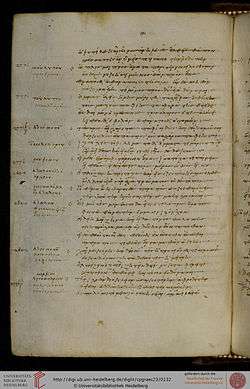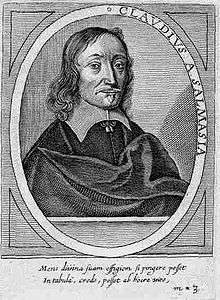Palatine Anthology

The Palatine Anthology (or Anthologia Palatina) is the collection of Greek poems and epigrams discovered in 1606 in the Palatine Library in Heidelberg.[1] It is based on the lost collection of Constantine Cephalas of the 10th century, which has been composed using older anthologies. It contains material from the 7th century BC until 600 AD and later on was the main part of the Greek Anthology which also included the Anthology of Planudes[2] and more material.
The manuscript of the Palatine Anthology was discovered by Saumaise (Salmasius) in 1606 in the Palatine library at Heidelberg[1] (Codex Palatinus 23). In 1623, after the Thirty Years' War, it was sent with the rest of the Palatine Library to Rome as a present from Maximilian I of Bavaria to Pope Gregory XV and it was kept in the Vatican Library. In 1797 it was taken to Paris by order of the French Directory and in 1816 it was returned to Heidelberg when the war ended, but one (smaller) part of it remained in Paris (Parisinus Suppl. Gr. 384).[3][4]
The manuscript

The manuscript of the Palatine Anthology consists of 709 pages. The section of the manuscript which is kept today at the Library of the University of Heidelberg (MS Pal. gr. 23) consists of pages 1–614, and the other part, housed in the Bibliothèque nationale de France, (Par. Suppl. gr. 384) comprises the remaining 94 pages (pp. 615–709).[5]
It was written by four scribes around 980. One of the scribes made comments and additions and part of the manuscript was corrected by a Corrector.
The scribes were the followings:[6]
- scribe Α: pages 4–9.384.8
- scribe J: pages 9.348.9-9.563 (possibly Constantine the Rhodian)[7]
- scribe Β: pages 9.564-11.66.3
- scribe Β2: pages 11.66.4-11.118.1
- scribe Β: pages 11.118.1-13.31
Scribe J made corrections to the text written by scribe A and at the end, a Corrector, C, made many corrections to the text of Α and J.
See also
References
- 1 2 Niall Livingstone, Gideon Nisbet (2010). Epigram. Classical Association (Great Britain), Cambridge University Press. p. 12. Retrieved October 2, 2011.
- ↑ Niall Livingstone, Gideon Nisbet (2010). Epigram. Classical Association (Great Britain), Cambridge University Press. p. 13. Retrieved October 2, 2011. "The Greek Anthology as we have it today consists of the fifteen Books of the Palatine Anthology followed by a 'Planudean Appendix' of 388 poems occurring in Planudes but not in the Palatine manuscript..."
- ↑ J. W. Mackail (1890). "Select Epigrams from the Greek Anthology". Longmans, Green, and Co. pp. Introduction, IV. Retrieved September 3, 2011.
- ↑ Sir William Smith, Charles Anthon (1862). A new classical dictionary of Greek and Roman biography, mythology and geography: partly based upon the Dictionary of Greek and Roman biography and mythology. Harper and brothers. p. 676. Retrieved September 4, 2011.
- ↑ Anacreon:With Thomas Stanley's translation. Edited by A.H. Bullen, Illustrated by J.R. Weguelin Introduction, σελ. xvii-xviii, London, Lawrence and Bullen, 1893
- ↑ The Garland of Philip, A.S.F. Gow and D.L. Page, page 1, Cambridge University Press, 1968
- ↑ The Poetics of Imitation: Anacreon and the Anacreontic Tradition, Patricia A. Rosenmeyer, Cambridge Univ. Press, 1992, p. 116, ISBN 978-0-521-41044-1
External links
| Wikimedia Commons has media related to Palatine Anthology. |
| Wikisource has original text related to this article: |
- Digitized manuscript of the Palatine Anthology online at the Heidelberg University Library.
- Epigrammatum anthologia palatina cum planudeis et appendice nova, Johann Friedrich Dübner-Cougny (edd.), 3 voll., Parisiis, editore Ambrosio Firmin-Didot, Instituti francici typographo, 1881-90: vol. 1, vol. 2, vol. 3.
- Greek text at Perseus Digital Library of the Tufts University, in five volumes: volume 1 (books I–VI), volume 2 (books VII–VIII), volume 3 (book IX), volume 4 (books X–XII), volume 5 (books XIII–XVI).
- Bilingual edition at the Internet Archive, originals with English translation: 1, 2, 3, 4, 5